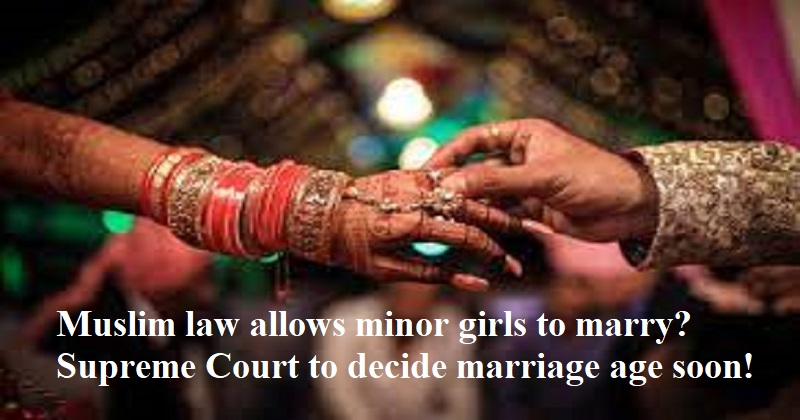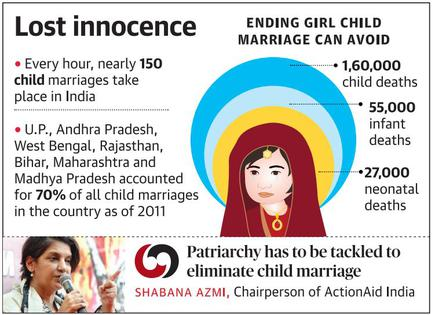Description

Copyright infringement not intended
About:
- The Supreme Court of India is to examine whether minor girls (under 18 years) can marry based on custom or personal law when marriages of minors are considered an offence under the law of the land.
- In India, the legal age for marriage is 18 years for women and 21 years for men.
- Marriage below this age is considered child marriage, and hence an offence.
Details:
- The Supreme Court Bench led by the Chief Justice of India had issued a notice on a petition filed by the National Commission for Protection of Child Rights (NCPCR) against a recent verdict of the Punjab and Haryana High Court that mentioned that a girl, on attaining puberty could be married based on Muslim personal law.
- The Government has introduced the Prohibition of Child Marriage (Amendment) Bill, 2021 to amend the Prohibition of Child Marriage Act (PCMA), 2006, to increase the minimum age of marriage for women from 18 to 21 years.
- It was referred to a parliamentary standing committee.
- According to the National Family Health Survey-5 report;
- In Jharkhand, 32.2% of women married before they turned 18 years.
- In West Bengal, 41.6% of women got married before they turned 18 years.
- In India, child marriage reduced from 47.4% in 2005-06 to 23.3% in 2020-21, according to the National Family Health Survey-5 (NFHS 5) data.
.jpeg)
Effects of early marriage:
- Girls who got married before the age of 18 years lacked reproductive choices and were denied other rights, including education, autonomy and often a lack of livelihood.
- Nearly 59% of Indian girls in the 15-19 group suffer from anaemia.
- Early childbearing could result in poor maternal and child health and poor nutritional status.

Protection of Children from Sexual Offences (POCSO) Act:
- The POCSO Act was enacted in 2012.
- It is a gender-neutral act; it also recognizes that boys can also become victims of sexual violence as well.
- It defines a child as someone under the age of 18.
- It also specifically lays down stringent punishment for exposing children to or using them to create child sexual abuse material.
- The law lays down the procedures for reporting sexual crimes against children.
- It places the burden of proof on the accused, following ‘guilty until proven innocent’ unlike the IPC.
- The Act penalizes storage of pornographic material for commercial purposes with a punishment of up to 3 years, a fine, or both.
Child Marriage:
- As per Census 2011, over 12 million child marriages were reported in the country.
- Child Marriage is defined as a marriage of a girl or boy before the age of minimum legal age (18 years).
- The reason behind Child Marriage
- It is a widely practised social custom.
- Poverty and Illiteracy of a Child's parents.
- Social and Economic Condition of the family including the Cultural values of the family and the Surrounding Society.
- Lack of awareness about the harmful effects Lack of easy access to Schooling.
- Political Patronage: Due to Social acceptance politicians find it difficult to oppose the practice of child marriage as it may mean losing votes and Support.
- Child marriage is also widely reported to be used to traffic girls from poor and tribal families for either the Sex trade or as cheap labour.
- It is more prevalent in rural areas.
- Rates of Child marriage are highest in the Central and Western parts of India and lower in the eastern and southern parts of India.
- Result of Child Marriage;
- It Restricts access to education and better opportunities in the future.
- It limits the freedom of decision and promotes socio-economic and gender inequality.
- It is associated with multiple health risks, limited Knowledge and access to, and use of, Contraception and reproductive health services and information.

Prohibition of Child Marriage (Amendment) Bill 2021:
- According to the National Family Health Survey 2019-21 (NFHS-5), 23% of women between the age of 20 and 24 were married before 18 years of age.
- In India, the practice of child marriage was first legally prohibited in 1929 through the Child Marriage Restraint Act, of 1929.
- As per the 1929 Act, marriage of girls below the age of 14 years and boys below the age of 18 years was prohibited.
- This Act was amended in 1978 to increase the minimum age to 18 years for females, and 21 years for men.
- The Prohibition of Child Marriage Act, of 2006 replaced the 1929 Act, with the same minimum age limits.
- The Prohibition of Child Marriage (Amendment) Bill, 2021 seeks to increase the minimum age of marriage for females to 21 years.
- The Bill was referred to the Standing Committee on Education, Women, Children, Youth, and Sports on December 21, 2021.
- The Bill was introduced to amend the Prohibition of Child Marriage Act, of 2006.
- The main objective is to increase the minimum age of marriage for females to 21 years.
- Under the 2006 Act, a person married below the minimum legal age (18 years) may apply for dissolution within two years of reaching majority (before 20 years of age).
- The 2021 Bill is going to increase this to five years (23 years of age).
- Repeated pregnancies and Childbirth before they are physically mature and psychologically ready.
- In domestic violence, women feel powerless and lack access to vital resources and decision-making power
Significance of the Bill:
- Increasing the minimum age of marriage for females to 21 years, ensures gender equality, as the legal marriage age for males is already 21 years, different ages of marriage promote the Stereotype that wives must be younger than their husbands.
- The Bill increases the minimum age of marriage for females to 21 years. This signifies that a person married between 18 and 21 years may also apply for voiding the marriage.
- Increasing the age of marriage will help in achieving various goals including improvement of maternal and infant mortality rates (IMR and MMR), nutrition levels, the sex ratio at birth (SRB), female labour force participation, and gender equality, and will lead to the empowerment of women.
Concern:
- About a quarter of 20-24-year-old women are married before the age of 18 years, despite that being the minimum age of marriage since 1978.
- The limited success of the current law raises the question of whether an increase in the minimum age would have any significant impact on reducing the incidence of child marriage
- According to NFHS-5 (2019-21), the prevalence of underage marriages remains high, with 23% of women between 20 and 24 years of age married before the age of 18. At the same time, the detection of such marriages remains low, with only 785 cases registered under the law in 2020.
- This raises the question of whether the increase in the minimum age would have any significant impact on reducing child marriages.
- Increasing the legal age for marriage for women will increase the number of marriages performed underage and render young adults without legal protection.
Steps by Government:
- Beti Bachao Beti Padhao to address the declining Child Sex Ratio.
- PM Matru Vandana Yojana (PMMVY) Providing Cash incentives for improved health and nutrition to pregnant and nursing mothers.
- Scheme for Adolescent Girls aims at girls in the age group 11-18, to empower and improve their social status through nutrition, life skills, home skills and vocational training
- Pradhan Mantri Mahila Shakti Kendra scheme promotes community participation through the involvement of Student Volunteers for the empowerment of rural women
- National Crèche Scheme to provide daycare facilities to children of the age group of 6 months to 6 years of working women who are employed.
- Rashtriya Mahila Kosh (RMK) to provide micro-credit to poor women for various livelihood support and income-generating activities at concessional terms
- Swadhar Greh provides relief and rehabilitation to destitute women and women in distress.
- Ujjawala is a Comprehensive Scheme for the prevention of trafficking and rescue, rehabilitation, reintegration and repatriation of victims of trafficking for commercial sexual exploitation.
- Working Women Hostels for ensuring safe accommodation for women working away from their place of residence.
- One-Stop Centre (OSC) and Women Helpline (WH) are being implemented to facilitate access to an integrated range of services including medical aid, police assistance, legal aid/ case management, psychosocial counselling and temporary support services to women affected by violence.
- Emergency Response Support System set up under Nirbhaya Fund.
- Mahila Police Volunteers, to report the incidences of violence against women.
- The dowry Prohibition Act, of 1961, Penalizes Giving & taking.
- SABLA Scheme, Providing life Skills and Supplementary nutrition to out-of Schoolgirls.
- The national database on Sexual offenders includes the name, addresses, photographs and fingerprint details of those Convicted in Sexual assault Cases.
- National Policy for Women, 2016
- Addresses women's issues throughout life-Cycle, issues from education, health, economic participation, decision making, violence, Creation of an enabling environment etc.
- In 2020, the Union government has set up a task force under Ms Jaya Jaitly, it suggested increasing the age of marriage for females to 21.
Way Forward:
- The issue of raising the age of marriage for women must be supported with other measures that help delay underage marriages such as access to education and improving women’s safety.
- The practice of child marriages is largely due to the overall social customs, tradition, illiteracy, poverty, low status of women in society, and lack of awareness. These issues cannot be tackled by legislative interventions alone.
- There is a need for improved access to education, skill training and employment opportunities, safety for women and strengthening maternal health services to reduce maternal and infant mortality rates.
- More awareness needs to be generated to make more children come forward for their child abuse.
- Proper training of police, forensic staff and public prosecutors need to be put in place for enhancement o the conviction rate.
- The introduction of sex education in schools and educating the children about good touch and bad touch is significant. In 2008-09 Parliamentary committee report mentions the introduction of sex education, but it never materialized. It has to be implemented.
- The Supreme Court issued a direction to set up special courts within 60 days in the districts that are having more than 100 pending POCSO cases. This has to be implemented urgently.

https://epaper.thehindu.com/Home/ShareArticle?OrgId=G7HAQD8FD.1&imageview=0















